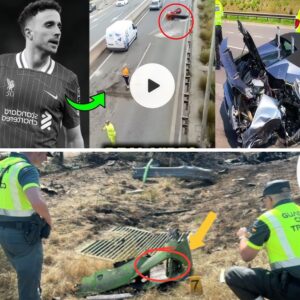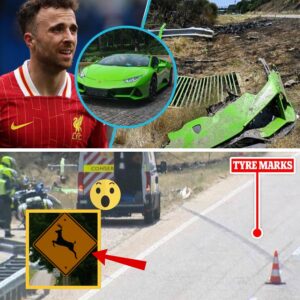BREAKING: Diogo Jota’s Car GPS Data Reveals 17-Minute Detour to a Forest Road Marked “Do Not Drive Here” in Google Maps
The football world remains in mourning following the tragic deaths of Liverpool FC star Diogo Jota and his brother André Silva in a car crash on July 3, 2025, in northwestern Spain. The accident, which occurred on the A-52 motorway near Zamora, has sparked intense speculation and investigation. Recent revelations from Jota’s car GPS data have added a haunting layer of mystery to the tragedy: the vehicle took a 17-minute detour onto a forest road that Jota had previously marked “Do Not Drive Here” in Google Maps just weeks before the crash. This article explores the details of the incident, the emerging GPS evidence, and the broader implications for road safety and personal navigation choices.

The Tragic Incident
On the night of July 2, 2025, Diogo Jota, 28, and his brother André Silva, 25, were traveling in a Lamborghini on the A-52 motorway in the municipality of Cernadilla, Zamora, when their vehicle veered off the road and burst into flames. Spanish authorities, specifically the Guardia Civil, initially reported that the crash was likely caused by a tire blowout while the car was overtaking another vehicle at high speed. Both brothers were pronounced dead at the scene, leaving behind Jota’s wife, Rute Cardoso, whom he married just 11 days prior, and their three young children. The football community, including teammates, fans, and global figures like Cristiano Ronaldo and Jürgen Klopp, expressed profound grief, with tributes pouring in from across the world.
Jota, a key figure in Liverpool’s Premier League title-winning campaign in the 2024/25 season, was en route to Santander to catch a ferry back to England for pre-season training, reportedly advised against flying due to recent lung surgery. His brother André, a professional footballer for Portuguese second-division club Penafiel, was accompanying him on the journey. The crash, which occurred around 12:30 a.m. local time, was initially attributed to a combination of excessive speed and a tire blowout, with investigators noting skid marks and debris scattered across the crash site.
The GPS Data Revelation

In a stunning development, investigators analyzing the Lamborghini’s GPS data uncovered that the vehicle had deviated from the A-52 motorway for approximately 17 minutes, taking a detour onto a remote forest road near the crash site. This road, described by locals as poorly maintained and riddled with potholes, was not part of the expected route to Santander. Most shockingly, the GPS data revealed that Jota had marked this specific road in Google Maps with a custom note reading “Do Not Drive Here” just weeks before the crash, raising questions about why the brothers ended up on this hazardous path.
The forest road, located near the Portuguese border, is known for its narrow, winding layout and lack of proper signage, making it a risky choice for high-speed vehicles like a Lamborghini. Local reports have long criticized the condition of roads in the Zamora region, with some describing the A-52 itself as a “goat track” due to its potholes and uneven surfaces. However, the specific forest road taken during the detour was not part of the main highway and was considered even more treacherous. One local commented on social media, “The road is a real danger. I drove it once in 2023, and it was in a terrible state. It’s unbelievable anyone would choose to go there, especially at night.”
Theories and Speculation

The discovery of the detour has sparked numerous theories about why Jota, who was likely driving based on police findings, chose to navigate this dangerous road despite his prior warning. Several possibilities are being explored by investigators and the public alike:
-
Navigation Error: One theory suggests that Jota’s GPS or Google Maps may have malfunctioned, leading the brothers onto the forest road unintentionally. Google Maps has faced criticism in the past for directing drivers onto unsafe or unsuitable routes, as seen in a 2019 incident where drivers following a detour ended up stuck in a field. However, Jota’s explicit warning in Google Maps complicates this theory, as it indicates he was aware of the road’s dangers.
-
Intentional Detour: Another possibility is that Jota deliberately chose the forest road, perhaps to avoid a perceived issue on the A-52 or to take a shortcut. This theory is supported by the fact that Jota was reportedly familiar with the region, having grown up in nearby Porto, Portugal. However, the “Do Not Drive Here” note suggests he had previously deemed the road unsafe, making this choice puzzling.
-
External Factors: Some speculate that external factors, such as an animal crossing the road or an obstruction on the A-52, may have forced Jota to divert onto the forest road. A truck driver, Jose Azevedo, who witnessed the crash and attempted to assist, disputed police claims of excessive speed, stating, “They were not speeding. I could see the car clearly, and I know that road. It’s dark and treacherous.” Azevedo’s account suggests that road conditions or other unforeseen circumstances may have played a role.
-
Mechanical Issues: The police’s initial report of a tire blowout remains a central focus of the investigation. The detour onto the forest road, with its uneven terrain, could have exacerbated existing tire damage, leading to the catastrophic failure that caused the crash. The Guardia Civil is examining tire marks and vehicle data to determine whether the blowout occurred before or during the detour.
Conflicting Witness Accounts
Adding to the complexity, witness accounts have provided conflicting details about the moments leading up to the crash. Azevedo, the truck driver who filmed the incident, insisted that the Lamborghini was traveling at a moderate speed, contradicting police claims of “significant speeding.” Another truck driver, interviewed by Spanish outlet MARCA, reported being overtaken by Jota’s vehicle five minutes before the crash at what they described as a “moderate speed.” These discrepancies have fueled debates about whether speed, road conditions, or the detour itself was the primary cause of the tragedy.
Implications for Road Safety and Navigation Technology
The revelation of Jota’s detour raises broader questions about the reliability of GPS navigation systems and the condition of rural roads in regions like Zamora. Google Maps, while a powerful tool, has been criticized for occasionally directing drivers onto unsafe routes, particularly in remote areas with outdated or incomplete mapping data. The fact that Jota had marked the forest road as dangerous suggests he relied on personal annotations to navigate, yet still ended up on the very path he sought to avoid. This incident may prompt calls for improved algorithms in navigation apps to prioritize road safety over speed or distance.
Additionally, the poor condition of roads in the Zamora region has come under scrutiny. Locals have long complained about potholes and inadequate maintenance on the A-52 and surrounding routes, with some arguing that these conditions contributed to the crash. While police have stated that the A-52 is not an accident “black spot,” the detour onto the forest road highlights the risks of navigating poorly maintained secondary routes, especially at night.
Tributes and Legacy
As investigations continue, the football community remains focused on honoring Jota and his brother. Liverpool FC postponed pre-season training, and players, including Virgil van Dijk and Mohamed Salah, attended the brothers’ funeral in Gondomar, Portugal, on July 5, 2025. Fans have left flowers, scarves, and messages at Anfield, with one banner reading, “Diogo lives forever.” The Portuguese Football Federation described Jota as “an extraordinary person” whose legacy would endure, while UEFA held a minute’s silence at the Women’s Euros match between Portugal and Spain.
Jota’s contributions to Liverpool, including 65 goals in 182 appearances and a Premier League title, cemented his status as a club legend. His brother André, though less prominent, was remembered as a dedicated professional at Penafiel. Their deaths, just weeks after Jota’s wedding, have left an indelible mark on the sport and their hometown of Porto.
Conclusion
The tragic deaths of Diogo Jota and André Silva have left a void in the football world, compounded by the perplexing details of their final journey. The discovery of a 17-minute detour onto a forest road marked “Do Not Drive Here” raises unsettling questions about the circumstances of the crash. As investigators piece together the evidence, the incident serves as a sobering reminder of the dangers of rural roads and the complexities of modern navigation systems. For now, the focus remains on celebrating the lives of two talented brothers whose passion for football touched millions, while their families and fans seek answers and solace in the face of unimaginable loss.





